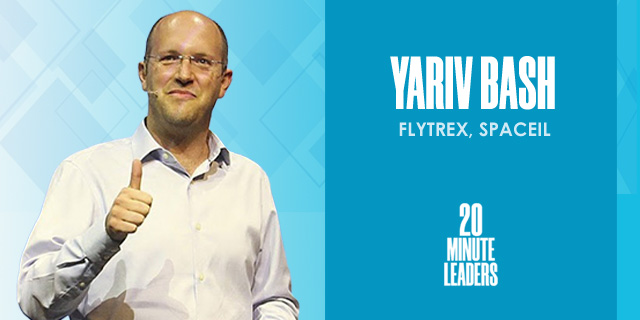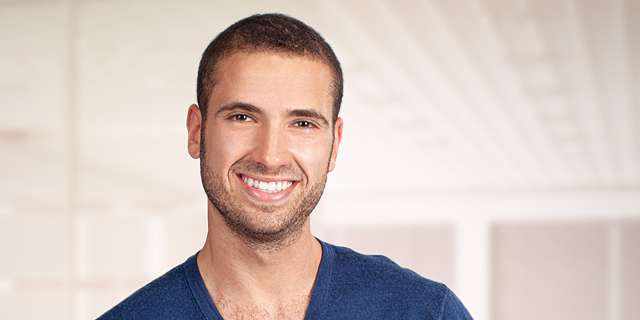
20-Minute Leaders
“I want to show that drone delivery is in the near future.”
Yariv Bash, CEO of Flytrex, says commercial drone delivery operations will be expanding quickly in the next two years
Click Here For More 20MinuteLeaders
What's happening with Flytrex and the drone delivery market today?
The good news is that people are starting to believe that this is just around the corner. Drone deliveries have been a pie in the sky for so many years. It's been a long journey, as it should be, because we are talking about flying unmanned machines above our heads. But we are already starting to see some initial commercial operations in the US and around the world. We think that we're going to see that expanding pretty rapidly in the next year or two.
Take me back to the challenges of the drone delivery market.
I like to give an example from the medical world. You can order a few chemicals, go to a lab, and create something. But from there to certifying that thing as a treatment, it's a very long journey.
It's the same with drones. The hard part is not putting the carbon parts together. The hard part is getting a commercial airplane certified. When it comes to that, we are nearing the end of our very long journey. In 2022, we are going to see the first few companies, including Flytrex, with certified commercial unmanned airplanes flying above our heads.
Take me back into this long, incredible journey of Flytrex.
Basically until now, every commercial pilot that you've seen, especially with drone deliveries, was very much limited anywhere around the world. It was very limited because it was based on waivers and exemptions around the current regulatory framework. The aviation authorities anywhere around the world are not really looking at your drone or your airplane. They're just doing a minimal certification for the operator.
Back in 2018, the FAA said, “We have to build the framework for commercial drone deliveries." What we've been doing since then is working with the FAA on certifying our system as if it was a commercial airplane. That's a very different process than a few days of training.
As we're nearing the end of that process, we're already starting to get approval in the form of waivers and exemptions. It's still not a blanket for national operations. They are the kind of approvals that propel us on the right path toward large-scale approval.
Paint me a picture about what this is like for you as the CEO of a small team, standing alongside giants like Amazon and Google and getting those same approvals.
The first thing was to get into the mindset of the FAA. It's very different from working in Israel. You have to be as strict as possible because that's how you're measured. You can't bluff. You have to do everything by the book, and that's okay. If you want to play in the big game, you have to follow those rules.
We basically built a whole regulatory team here in Israel from scratch. We are talking about thousands of pages of manuals. That's how it works in aviation. I think it's tougher than even medical approvals. It's hard. But if you follow the rules and you realize that this is a marathon, not a sprint, then you can make it to the finish line. Hopefully.
What are these two milestones that happened recently? Why are they so monumental?
Basically, we've received an approval from the FAA to fly in three locations up to one mile away, which allows us to start making deliveries to almost two orders of magnitude more customers. We've got three stations working every day in North Carolina, and we can serve almost 10,000 families.
That's already something that's working. We've got customers that are dependent on us. They want to get their hamburger or their pizza delivered. We're starting to see the actual commercial traction. It's still early days. We still have a lot to learn. But it's already happening on a daily basis. I think New Year’s Eve was the busiest day in terms of deliveries performed.
We’re transitioning from a company that focuses solely on regulations and technology to a company that also handles marketing, B2C, and customer success. It's another challenge and we love challenges. So we're happy.
How many years were you working on the regulation and the technology side before going to the commercialization?
It's actually four to five years, and it's not going to get easier. The regulations are only going to get harder. It doesn't matter if you're Flytrex from Tel Aviv or Boeing from Seattle, it takes you four to five years even if it's your 20th airplane.
All of the current 15- to 20-minute delivery companies are working in a niche market in the US. Most of the US population is in the suburbs. Those companies are working in densely populated areas in major cities. In the suburbs, it doesn’t make sense for those services to work. The population density isn't high enough.
Roughly two thirds of the US population lives in private houses in the suburbs. That's where the major market is at. Most of those companies have been focused on highly populated areas because that's where the unit economy using human couriers works.
In the suburbs, you cannot optimize because all the restaurants and customers are spread out. Your couriers have to use a car. Everything costs a lot more.
That's where the model for a typical on-demand service breaks down. Using drones is not the best user experience for customers in apartment buildings. But I am the best user experience for the major part of the US.
The second big announcement was your most recent financing round. What's happening there?
We've just announced a $40 million round, which brings the total amount raised until now by Flytrex to $60 million. The goal of this round is to actually start deploying stations and to show how we can break even in those stations, which is the holy grail for every on-demand company in the world.
We want to show that this is in the near future. We want to reach a point where this is starting to make significant money before we go to the national scale in the US. It's not an easy goal. It's going to take about a year to reach that point. But we're focusing on that.
What is that like switching the hats from Yariv the technologist to Yariv the businessman trying to optimize the unit economics?
We've always had that in the back of our heads. If you look at the technical specs of our drones compared to other modes, they have the shortest distance, and for a reason. They were built in a way to justify a five-dollar burrito delivery. It requires a different kind of vehicle. That was always in the back of our heads as we designed the entire system. Now it's time to prove that it works on increasing scales.
Anything that's related to B2C and marketing is becoming more of our focus these days. We are up for the challenge. We actually are happy to expand our horizons.
What are you most excited about?
Making the delivery; seeing the customers' responses. Seeing it in action every day, that's an incredible experience. That's the fun part after working on it for so many years just in the field without actual customers.
The exciting part is just growing the amount of deliveries and families that we can service and, basically, writing the book on how you open a station, how you market it, how to get to more people, creating a service that people love and like to use almost daily.
Michael Matias, Forbes 30 Under 30, is the author of Age is Only an Int: Lessons I Learned as a Young Entrepreneur. He studies Artificial Intelligence at Stanford University, is a Venture Partner at J-Ventures and was an engineer at Hippo Insurance. Matias previously served as an officer in the 8200 unit. 20MinuteLeaders is a tech entrepreneurship interview series featuring one-on-one interviews with fascinating founders, innovators and thought leaders sharing their journeys and experiences.Contributing editors: Michael Matias, Megan Ryan
